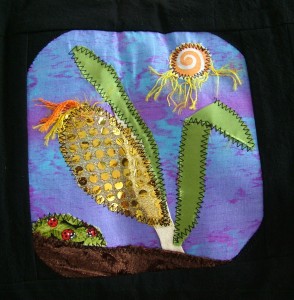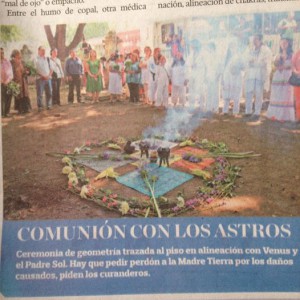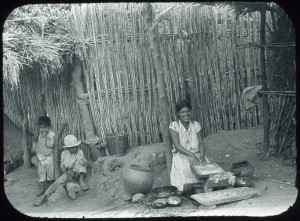On this page we are assembling materials that might be useful for designing curriculum relating to maize (also called “corn,” especially in American English), whether for a science class or an art class or almost any discipline that might seek to incorporate an appreciation for the staff of life in Mesoamerica.

Detail, maize quilt curated by Marietta Bernstorff, San Agustín Etla, Oaxaca, Mexico. (S. Wood, 2010)
The essence of life. Listen to this interview with Ellen Messer, hosted by Mesolore, speaking about the significance of maize or corn to indigenous life. This interview is in English with Spanish subtitles. Go to the point just beyond 3 minutes into the interview, and again at about 4 and a half minutes.

Ceramic representations of corn cobs from a pre-Columbian Zapotec community. Princeton museum. Shared by Pearl Lau, 2015.
Bryan Just, Curator and Lecturer in the Art of the Ancient Americas at Princeton University Art Museum, suggests that these sculptures were made using real cobs. The two that appear above may have been, at one time, part of a headdress of maize that was part of larger urn, as shown below. The cobs are extremely lifelike in their arrangement of kernels.
Maize cobs could be anthropomorphized in pre-Hispanic art. Note the faces on these cobs on a mural from Cacaxtla, Puebla (in a reproduction found in the Museum of Natural and Cultural History in Mexico City):
 Photo by Robert Haskett, 2005.
Photo by Robert Haskett, 2005.
Colors
Maize comes in multiple colors in Mesoamerica. Some scholars have linked the more prominent colors that we see in maize varieties with the colors associated with the cardinal directions. If the colors of the universal directions can be linked to maize, that would reinforce this most prized staple of the Mesoamerican diet as culturally central.
To exemplify the possible connections, in one study of Maya astrology, red is linked to the east (initiation, unit), west with black (adjusting, duality), north with white (reduction, diminishing), and south with yellow (increase, harvest). In another study of the Maya, the associations related to the years, to calendrics. In yet another, animal associations are connected with the cardinal directions and the colors. One could investigate whether there are such linkages among the cultures of Oaxaca, and if so, how they are explained. In one examination of Oaxacan textiles, the four cardinal directions have these associations: yellow with east, red with north, blue and green with west, and white with south — so very different from the Maya zone. Below, one of the maize colors appears blue, and probably any of us have eaten what are called “blue” tortilla chips.
Mesoamerican art is full of symbols representing the four cardinal directions. They often include a center, and they can imply a vertical axis that takes in the heavens and the underworld. They can include a cross. Here is a link to a variety of images of this quincunx. The Aztec empire is shaped like this cross, with an eagle on a cactus at its center, in the sixteenth-century Codex Mendoza. It is found on the Maya’s Madrid Codex and the Aztec/Borgia group’s Codex Fejervary Mayer. It is also represented in the Nahua (or Aztec) calendar sign for movement. The calendar itself might take this shape in the minds of some observers.

Quincunx with ears of corn pointing to the four cardinal directions. Publicity for an event at the Railroad Museum in Oaxaca, July 2014.
Origins
As we will learn at the Ethnobotanical Garden in Oaxaca, “teosinte” is the name of the earliest ancestor of maize (or corn), which grows in this region and which was domesticated and improved until it became a more edible, cob-like plant.
“Greenhouse Time Machine,” (about a recent Smithsonian experiment with teosinte), Feb. 3, 2014
http://www.ediblegeography.com/greenhouse-time-machine/
A creative commons image of the plant can be found here:
http://commons.wikimedia.org/wiki/File:Teocinte_Oax_5_agosto_2008_063.jpg
The scientific name for teosinte is “zea,” which is described in Wikipedia:
http://en.wikipedia.org/wiki/Zea_(genus) which also offers more images that may be useful.
Here’s a short article in Spanish about teosinte and maize:
http://www.eluniversal.com.mx/cultura/63999.html
For information about milpa agriculture, please see the page about our excursion to Teotitlán del Valle.
Human Origins
We should look for cultural origin stories from the area of Oaxaca that relate to maize or maize dough. Below is a posting from a native speaker of Nahuatl (from central Mexico), with a drawing he made that he based upon a human origin story that came down to him through oral tradition in his family.
“Maize is Our Life” Exhibition
Curator Marietta Bernstorff organized an exhibition around maize at the Curtiduría art center in 2007.
Genetically Modified Corn
There is an opposition movement intended to protect “maíz criollo” or Native corn and reject genetically modified corn. This movement is embodied in the art seen around Oaxaca called, “Sin Maíz, No Hay País,” (Without Maize, No Country).

“Sin Maíz, No Hay País” (quilt detail), with the Mexican republic shape in paisley fabric. Project curated by Marietta Bernstorff. (S. Wood, 2010)

“No country without maize,” a slogan in support of indigenous maize, or maize autonomy, and in opposition to genetically modified maize. ASARO(?) print. Ca. 2010.

Corn cobs like bombs, and a grasshopper with a gas mask. A commentary on genetically modified corn. (Photo, ASARO collective)

Detail from a codex-like pattern on a building in a Oaxacan neighborhood. (Photo, S. Wood, July 2014)

First State Fair in “Defense of Our Milpa and Our Native Maizes,” June 2014. Note the pre-Hispanic carvings of corn cobs used by the poster makers. (Photo of poster, S. Wood)
Articles in English:
http://stopthecrop.org/news/sin-maiz-no-hay-paiz-without-corn-there-no-country
http://attempter.wordpress.com/2013/10/14/for-mexico-without-corn-there-is-no-country/

Poster against GM maize with reference to Coatlicue, a pre-Columbian Aztec goddess. By street artist Chula of San Francisco. (Photo, S. Wood, Oaxaca, Nov. 2013)
The print, above, hangs in a café in Oaxaca. “Viva la Milpa,” means long live the cornfield (using the traditional word that derives from the Nahuatl language). The artist gives thanks to “Coatlicue,” a goddess in the Aztec/Nahua pantheon.

Street artist ALHIL captures a reverence for the milpa in this mural featuring an indigenous woman farming. (Photo, Itandehui F. Ortiz, Oaxaca, 2013)
The café called Itanoní in north-central Oaxaca city emphasizes food that are local, organic, and not genetically modified. Maize is their most prized staple, and they only sell foods made from “maíz criollo” (Oaxacan maize, developed over thousands of years). Here is a YoutTube video about “The Flower of Corn,” featuring Itanoní owner, Amado Ramírez Leyva.

Café Itanoní expresses its preference for “maíz criollo” and shares a legend about a red-ant-turned-black-ant and its role in the development of maize. (S. Wood, 2009)
The term “milpa” (from the Nahuatl, milli, field, and –pa, meaning toward) or cornfield, is pervasive in Mexican Spanish. It can have a romance to it, an idealization of rural life and an affection for maize that is central to the diet and therefore to survival. The company that bears the name “La Milpa” in this market in Oaxaca (below) exemplifies this way of thinking. Incidentally, the Nahuatl word tamalli (Hispanized as tamal, singular, and tamales, plural) refers to another enduring element in the Mesoamerican diet. Atole, also mentioned on the sign, comes from the Nahuatl atolli, and refers to a hot corn gruel beverage, sometimes flavored with chocolate, strawberry, and other flavors.
A campesino (rural) couple coming in from the milpa are featured in this mural in the former municipal palace on the zócalo. The mural was painted by García Bustos.
Early Twentieth-Century Photography
Below we have a scene of a campesino plowing his milpa with a yoke of oxen. This was shot somewhere in the state of Oaxaca in perhaps the 1930s or 1940s. The photographer is unknown. The slides from this photographer, some of which continue below, now reside in WHP collections.
The use of oxen is still prevalent in rural Oaxaca today. Horse-drawn carts are also seen.
Twentieth-Century Muralism

Indigenous women making tortillas, as imagined by Diego Rivera in a mural in the National Palace, Mexico City. (S. Wood, 2003)
More Art (Contemporary)
Maize-theme art projects include these galleries:
http://americantapestryalliance.org/exhibitions/tex_ata/maiz/gallery/

Larger maize quilt from the women and maize art project curated by Marietta Bernstorff, San Agustín Etla. (S. Wood, 2010)
Smithsonian Videos (YouTube)
- “Maize in America: Cantaré,” (2009, 48:43) http://www.youtube.com/watch?v=hBwd_sC40m8
- “Maize in America: AWAL,” (2009: 27:59) http://www.youtube.com/watch?v=ulumBP99Mn4

An ear of corn with a considerable fungus growth, called Huitlacoche, which is a delicacy. (Photo, S. Wood, July 2014)
Recommended Readings
- “’Maize has a Soul’: Rincón Zapotec Notions of Living Matter” [Download PDF], inZapotec Science: Farming and Food in the Northern Sierra of Oaxaca (University of Texas Press, 2001) [Download Notes]
- Betty Fussell, “Translating Maize into Corn: The Transformation of America’s Native Grain,” Social Research, Spring 1999 [Download PDF]
- “Biodiversity in Danger: The Genetic Contamination of Mexican Maize,” Americas This Week (6/24/2004)
- Brief article on maize and the North American Free Trade Agreement (NAFTA), “NAFTA Took a Big Toll on Mexican Small Corn Farmers,” 2/18/2011
- Edgar Anderson and John Jay Finan, “Maize in the Yanhuitlan Codex” [Download PDF], Annals of the Missouri Botanical Garden 32:3 (1945), 361–368
Curricula from 2010 and 2011
Stephanie Tietz, high school science unit, “Incorporating Mesoamerican Content Into the Biology Curriculum” (2010)
Maureen Yoder, elementary art lesson, “Maize Codex” (2011)
- Ethnobotanical Lesson Plan 1: Maize Codex (DOC)
- Maize Worksheet – Side 1 (GIF)
- Maize Worksheet – Side 2 (GIF)
- Maize Codex – Finished example (JPEG)
ESOL/ESL/ELL/EFL (Various Levels) (20110
- Deborah Brady – ESL grade 4+, intermediate level – Mesoamerican Foods
- Unit Information (DOC)
- Mesoamerican Legend About Corn (DOC)
- My Favorite Foods (DOC)
- Presentation (PPT)
- Delisa Brown-Guc – 9th Grade English Language Learners (ELL)
- Unit Information (DOC)
- Ethnobotanical Garden (PPT)
- Oaxaca (PPT)
- Genetically Modified Corn – a Debate (PPT)
- Susannah Courand – ESL Biology 1 – Maize: Science Impacting Culture From Early Mesoamerica to Modern Day
- Unit information (DOC)
- Rubric for Brochures (DOC)
- Timeline Sorting Activity (DOC)
- Maize ESL Biology 1 (PPT)
- Jennifer May – High School ELL “Cooking demonstration” lesson plan – Intermediate
- Unit Information (DOC)
- Recipe Worksheet (DOC)
- Presentation Rubric (DOC)
- Cooking Show Rubric (DOC)
- “Dark Chocolate Chicken Mole Tamales” Example Cooking Show Video w/ Jennifer May (Youtube)






















